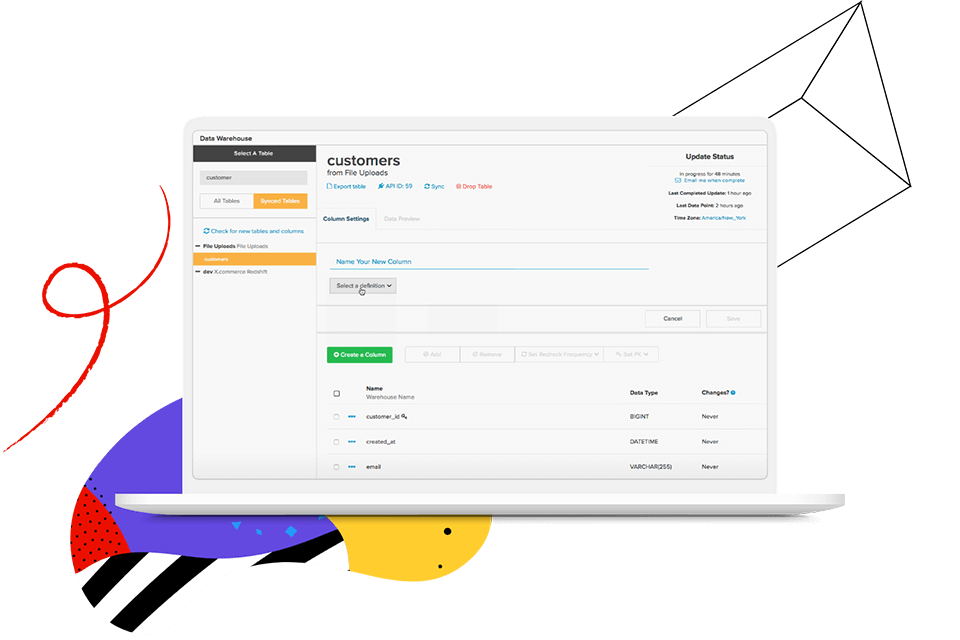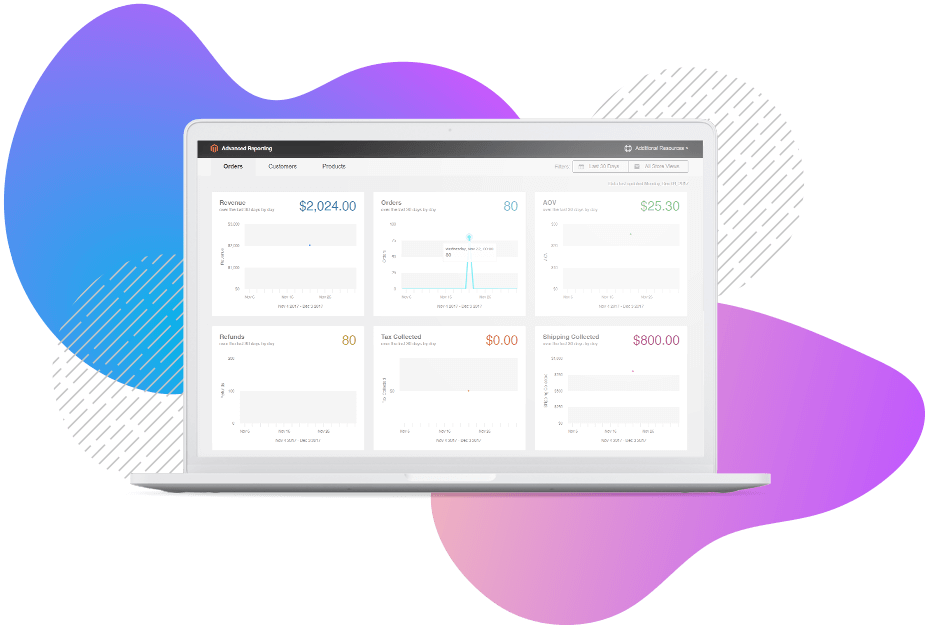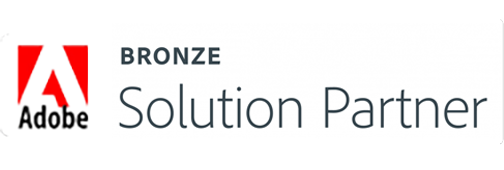- SAP Business One
- Online Shop & Web Design
- IT & Cloud
- Digital Marketing
- References
- About Us
Analyse data and eliminate challenges with a central solution
Business intelligence ecommerce solutions make monitoring business health simple. Analyse data from across your operations and never worry about figuring out your Average Order Value, Customer Lifetime Value or Retention rates again. Learn all about business intelligence solutions and what to expect from a business intelligence platform.
Every day, your business generates huge amounts of data from sales and logistics channels, social media platforms and elsewhere. Harnessing this information is important - organisations which make data-led decisions are more likely to be high financial performers. But with so many platforms storing your data, how do you connect the dots?
Business intelligence is the process of gathering and analysing this data. Used effectively, it can help you:
Business Intelligence platforms - such as Adobe Commerce, powered by Magento - bring all your data together in one place. They store, sync and present information from across your operation in a cloud-based warehouse - so you can analyse, learn and make data-driven decisions.
Business intelligence is often used interchangeably with business analytics, but there are subtle differences.
Business analytics is a sub-section of business intelligence. It uses data gathered from business intelligence to anticipate trends and outcomes, encompassing:
So, if you’ve had a regional spike in sales, this will be reflected in your business intelligence data. You can drill down into the specifics of where these sales are happening and why the spike occurred.
At this point, analytics steps in and answers the ‘why’. This helps you to make informed predictions about the future - and decide if a regional spike in sales could become national.
There are many benefits to good business intelligence practice. These include:
Business intelligence can be a highly effective tool for your organisation, but it may present challenges:
To get the best from your enterprise intelligence platform, you’ll need a strategy. Follow these steps to get started:
Our business intelligence platform is built on Adobe Commerce, powered by Magento. Our out-of-the-box solution provides vital commerce dashboards that make it simple to monitor business health.
To learn how you can make the most of Adobe Commerce, powered by Magento, request a personal consultation.
Broadly, business intelligence incorporates the following:
Business intelligence is most used in sales, finance, operations and marketing departments. Its adaptability for processes, performance and predictions makes it a highly valuable asset across a range of industries. Business intelligence for eCommerce helps organisations of all sizes monitor their operations.
Some businesses have dedicated data and analytics professionals to monitor business intelligence. An example of this might be a data officer. A dedicated team in this area is very useful for larger businesses - but Adobe Commerce, powered by Magento makes business intelligence easy for smaller enterprises too.

Integrated data pipeline and data warehouse technology.

One platform to turn data into value.

Visualisations and tools to share insights with everyone.

Drive deeper analyses by adding a related third dimension to any report. Go from plotting x and y values to plotting x, y and z values which are represented by the size of the bubble. Group the bubbles by another attribute to segment even further and change the bubble colours.
Not sure if you have found the right service? No worries, we are here to assist! Just enter your email address to request a free initial consultation.
For inquiries or requests, we will make every attempt to respond within 48 hours or call us at +49 30 863 232 940
 Applicable for Package
Applicable for Package Optional
Optional
 Applicable for Package Applicable for Package Optional Optional |
Basic
300 €
|
Standard
1200 €
|
Plus
1900 €
|
Professional
2900 €
|
|---|---|---|---|---|
|
Company Database with basic settings
|
 |
 |
 |
 |
|
Standard Layouts with individual Logo and customization of the footer
|
 |
 |
 |
 |
|
Outlook Add-on Integration (5 users included)
|
 |
 |
 |
 |
| Reporting and analytics |  |
 |
 |
 |
| Access to Test Demo Database |  |
 |
 |
 |
| Web Client Activation |  |
 |
 |
 |
| Customization - Simple User Defined Fields (UDF) and User Define Tables (UDT) |  |
 |
 |
 |
|
Configuration of SAP Mobile App
|
 |
 |
 |
 |
|
Company Database with basic settings
|
 |
|
Standard Layouts with individual Logo and customization of the footer
|
 |
|
Outlook Add-on Integration (5 users included)
|
 |
| Reporting and analytics |  |
| Access to Test Demo Database |  |
| Web Client Activation |  |
| Customization - Simple User Defined Fields (UDF) and User Define Tables (UDT) |  |
|
Configuration of SAP Mobile App
|
 |
|
Company Database with basic settings
|
 |
|
Standard Layouts with individual Logo and customization of the footer
|
 |
|
Outlook Add-on Integration (5 users included)
|
 |
| Reporting and analytics |  |
| Access to Test Demo Database |  |
| Web Client Activation |  |
| Customization - Simple User Defined Fields (UDF) and User Define Tables (UDT) |  |
|
Configuration of SAP Mobile App
|
 |
|
Company Database with basic settings
|
 |
|
Standard Layouts with individual Logo and customization of the footer
|
 |
|
Outlook Add-on Integration (5 users included)
|
 |
| Reporting and analytics |  |
| Access to Test Demo Database |  |
| Web Client Activation |  |
| Customization - Simple User Defined Fields (UDF) and User Define Tables (UDT) |  |
|
Configuration of SAP Mobile App
|
 |
|
Company Database with basic settings
|
 |
|
Standard Layouts with individual Logo and customization of the footer
|
 |
|
Outlook Add-on Integration (5 users included)
|
 |
| Reporting and analytics |  |
| Access to Test Demo Database |  |
| Web Client Activation |  |
| Customization - Simple User Defined Fields (UDF) and User Define Tables (UDT) |  |
|
Configuration of SAP Mobile App
|
 |
 Applicable for Package
Applicable for Package Optional
Optional
 Applicable for Package Applicable for Package Optional Optional |
Standard
1200 €
|
Plus
1900 €
|
Professional
2900 €
|
|---|---|---|---|
| Predefined COA SKR03/SKR04 |  |
 |
 |
| Multiple Currencies |  |
 |
 |
| Setup of GL Account Determination |  |
 |
 |
| Set up of Tax Codes |  |
 |
 |
| Budgeting |  |
 |
 |
|
Cost Accounting
|
 |
 |
 |
|
Elster Configuration and processing
|
 |
 |
 |
| DATEV Configuration and Export |  |
 |
 |
| Assitance in applying SEPA Creditor Number |  |
 |
 |
| Financial Reports Setup |  |
 |
 |
| Fixed Assets Intialization and master setup |  |
 |
 |
|
INTRASTAT Configuration
|
 |
 |
 |
| Predefined COA SKR03/SKR04 |  |
| Multiple Currencies |  |
| Setup of GL Account Determination |  |
| Set up of Tax Codes |  |
| Budgeting |  |
|
Cost Accounting
|
 |
|
Elster Configuration and processing
|
 |
| DATEV Configuration and Export |  |
| Assitance in applying SEPA Creditor Number |  |
| Financial Reports Setup |  |
| Fixed Assets Intialization and master setup |  |
|
INTRASTAT Configuration
|
 |
| Predefined COA SKR03/SKR04 |  |
| Multiple Currencies |  |
| Setup of GL Account Determination |  |
| Set up of Tax Codes |  |
| Budgeting |  |
|
Cost Accounting
|
 |
|
Elster Configuration and processing
|
 |
| DATEV Configuration and Export |  |
| Assitance in applying SEPA Creditor Number |  |
| Financial Reports Setup |  |
| Fixed Assets Intialization and master setup |  |
|
INTRASTAT Configuration
|
 |
| Predefined COA SKR03/SKR04 |  |
| Multiple Currencies |  |
| Setup of GL Account Determination |  |
| Set up of Tax Codes |  |
| Budgeting |  |
|
Cost Accounting
|
 |
|
Elster Configuration and processing
|
 |
| DATEV Configuration and Export |  |
| Assitance in applying SEPA Creditor Number |  |
| Financial Reports Setup |  |
| Fixed Assets Intialization and master setup |  |
|
INTRASTAT Configuration
|
 |
 Applicable for Package
Applicable for Package Optional
Optional
 Applicable for Package Applicable for Package Optional Optional |
Standard
1200 €
|
Plus
1900 €
|
Professional
2900 €
|
|---|---|---|---|
|
Banks Setup
|
 |
 |
 |
|
Electronic Transactions
|
 |
 |
 |
|
Bank Statement Processing
|
 |
 |
 |
|
Payment Engine Add-on
|
 |
 |
 |
|
Banks Setup
|
 |
|
Electronic Transactions
|
 |
|
Bank Statement Processing
|
 |
|
Payment Engine Add-on
|
 |
|
Banks Setup
|
 |
|
Electronic Transactions
|
 |
|
Bank Statement Processing
|
 |
|
Payment Engine Add-on
|
 |
|
Banks Setup
|
 |
|
Electronic Transactions
|
 |
|
Bank Statement Processing
|
 |
|
Payment Engine Add-on
|
 |
 Applicable for Package
Applicable for Package Optional
Optional
 Applicable for Package Applicable for Package Optional Optional |
Standard
1200 €
|
Plus
1900 €
|
Professional
2900 €
|
|---|---|---|---|
| Vendor Groups |  |
 |
 |
| Landed Costs |  |
 |
 |
| Freight |  |
 |
 |
| Vendor Groups |  |
| Landed Costs |  |
| Freight |  |
| Vendor Groups |  |
| Landed Costs |  |
| Freight |  |
| Vendor Groups |  |
| Landed Costs |  |
| Freight |  |
 Applicable for Package
Applicable for Package Optional
Optional
 Applicable for Package Applicable for Package Optional Optional |
Standard
1200 €
|
Plus
1900 €
|
Professional
2900 €
|
|---|---|---|---|
|
CRM with lead management, contacts
|
 |
 |
 |
| Sales Employee |  |
 |
 |
| Dunning Terms |  |
 |
 |
|
CRM with lead management, contacts
|
 |
| Sales Employee |  |
| Dunning Terms |  |
|
CRM with lead management, contacts
|
 |
| Sales Employee |  |
| Dunning Terms |  |
|
CRM with lead management, contacts
|
 |
| Sales Employee |  |
| Dunning Terms |  |
 Applicable for Package
Applicable for Package Optional
Optional
 Applicable for Package Applicable for Package Optional Optional |
Standard
1200 €
|
Plus
1900 €
|
Professional
2900 €
|
|---|---|---|---|
|
Warehouse Management with locations, batches and serial numbers
|
 |
 |
 |
| Item Groups |  |
 |
 |
| Item Properties |  |
 |
 |
| Unit of Measure and UoM Groups Setup |  |
 |
 |
| Weight, Length and Width Setup |  |
 |
 |
| Manufacturer |  |
 |
 |
| Shipping Types |  |
 |
 |
| Inventory Cycle |  |
 |
 |
| Package Types |  |
 |
 |
|
Warehouse Management with locations, batches and serial numbers
|
 |
| Item Groups |  |
| Item Properties |  |
| Unit of Measure and UoM Groups Setup |  |
| Weight, Length and Width Setup |  |
| Manufacturer |  |
| Shipping Types |  |
| Inventory Cycle |  |
| Package Types |  |
|
Warehouse Management with locations, batches and serial numbers
|
 |
| Item Groups |  |
| Item Properties |  |
| Unit of Measure and UoM Groups Setup |  |
| Weight, Length and Width Setup |  |
| Manufacturer |  |
| Shipping Types |  |
| Inventory Cycle |  |
| Package Types |  |
|
Warehouse Management with locations, batches and serial numbers
|
 |
| Item Groups |  |
| Item Properties |  |
| Unit of Measure and UoM Groups Setup |  |
| Weight, Length and Width Setup |  |
| Manufacturer |  |
| Shipping Types |  |
| Inventory Cycle |  |
| Package Types |  |
 Applicable for Package
Applicable for Package Optional
Optional
 Applicable for Package Applicable for Package Optional Optional |
Standard
1200 €
|
Plus
1900 €
|
Professional
2900 €
|
|---|---|---|---|
| Address format setup |  |
 |
 |
| Country Setup |  |
 |
 |
| Payment Terms |  |
 |
 |
| Address format setup |  |
| Country Setup |  |
| Payment Terms |  |
| Address format setup |  |
| Country Setup |  |
| Payment Terms |  |
| Address format setup |  |
| Country Setup |  |
| Payment Terms |  |
 Im Plan enthalten
Im Plan enthalten Optional
Optional
 Im Plan enthalten Im Plan enthalten Optional Optional |
Basic
300 €
|
Standard
1200 €
|
Plus
1900 €
|
Professional
2900 €
|
|---|---|---|---|---|
|
Firmendatenbank (Grundeinstellung)
|
 |
 |
 |
 |
|
Standard-Belege, mit individuellem Logo und Anpassung der Fußzeile
|
 |
 |
 |
 |
|
Integration des Outlook-Add-ons (für 5 Benutzer inbegriffen)
|
 |
 |
 |
 |
| Berichtswesen und Analysen |  |
 |
 |
 |
| Zugang zur Test-Demodatenbank |  |
 |
 |
 |
| Web-Client-Aktivierung |  |
 |
 |
 |
| Anpassung - Einfache benutzerdefinierte Felder (UDF) und benutzerdefinierte Tabellen (UDT) |  |
 |
 |
 |
|
Konfiguration der SAP Mobile App
|
 |
 |
 |
 |
|
Firmendatenbank (Grundeinstellung)
|
 |
|
Standard-Belege, mit individuellem Logo und Anpassung der Fußzeile
|
 |
|
Integration des Outlook-Add-ons (für 5 Benutzer inbegriffen)
|
 |
| Berichtswesen und Analysen |  |
| Zugang zur Test-Demodatenbank |  |
| Web-Client-Aktivierung |  |
| Anpassung - Einfache benutzerdefinierte Felder (UDF) und benutzerdefinierte Tabellen (UDT) |  |
|
Konfiguration der SAP Mobile App
|
 |
|
Firmendatenbank (Grundeinstellung)
|
 |
|
Standard-Belege, mit individuellem Logo und Anpassung der Fußzeile
|
 |
|
Integration des Outlook-Add-ons (für 5 Benutzer inbegriffen)
|
 |
| Berichtswesen und Analysen |  |
| Zugang zur Test-Demodatenbank |  |
| Web-Client-Aktivierung |  |
| Anpassung - Einfache benutzerdefinierte Felder (UDF) und benutzerdefinierte Tabellen (UDT) |  |
|
Konfiguration der SAP Mobile App
|
 |
|
Firmendatenbank (Grundeinstellung)
|
 |
|
Standard-Belege, mit individuellem Logo und Anpassung der Fußzeile
|
 |
|
Integration des Outlook-Add-ons (für 5 Benutzer inbegriffen)
|
 |
| Berichtswesen und Analysen |  |
| Zugang zur Test-Demodatenbank |  |
| Web-Client-Aktivierung |  |
| Anpassung - Einfache benutzerdefinierte Felder (UDF) und benutzerdefinierte Tabellen (UDT) |  |
|
Konfiguration der SAP Mobile App
|
 |
|
Firmendatenbank (Grundeinstellung)
|
 |
|
Standard-Belege, mit individuellem Logo und Anpassung der Fußzeile
|
 |
|
Integration des Outlook-Add-ons (für 5 Benutzer inbegriffen)
|
 |
| Berichtswesen und Analysen |  |
| Zugang zur Test-Demodatenbank |  |
| Web-Client-Aktivierung |  |
| Anpassung - Einfache benutzerdefinierte Felder (UDF) und benutzerdefinierte Tabellen (UDT) |  |
|
Konfiguration der SAP Mobile App
|
 |
 Im Plan enthalten
Im Plan enthalten Optional
Optional
 Im Plan enthalten Im Plan enthalten Optional Optional |
Standard
1200 €
|
Plus
1900 €
|
Professional
2900 €
|
|---|---|---|---|
| Vorgefertigter Kontenplan SKR03/SKR04 |  |
 |
 |
| Mehrere Währungen |  |
 |
 |
| Einrichtung der Sachkontenfindung |  |
 |
 |
| Einrichtung von Steuerkennzeichen |  |
 |
 |
| Budgetierung |  |
 |
 |
|
Kostenrechnung
|
 |
 |
 |
|
Elster-Konfiguration und -Verarbeitung
|
 |
 |
 |
| DATEV-Konfiguration und Export |  |
 |
 |
| Unterstützung bei Beantragung einer SEPA-Gläubiger-Nummer |  |
 |
 |
| Einrichtung von Finanzberichten |  |
 |
 |
| Initialisierung und Stammeinrichtung von Anlagevermögen |  |
 |
 |
|
INTRASTAT-Konfiguration
|
 |
 |
 |
| Vorgefertigter Kontenplan SKR03/SKR04 |  |
| Mehrere Währungen |  |
| Einrichtung der Sachkontenfindung |  |
| Einrichtung von Steuerkennzeichen |  |
| Budgetierung |  |
|
Kostenrechnung
|
 |
|
Elster-Konfiguration und -Verarbeitung
|
 |
| DATEV-Konfiguration und Export |  |
| Unterstützung bei Beantragung einer SEPA-Gläubiger-Nummer |  |
| Einrichtung von Finanzberichten |  |
| Initialisierung und Stammeinrichtung von Anlagevermögen |  |
|
INTRASTAT-Konfiguration
|
 |
| Vorgefertigter Kontenplan SKR03/SKR04 |  |
| Mehrere Währungen |  |
| Einrichtung der Sachkontenfindung |  |
| Einrichtung von Steuerkennzeichen |  |
| Budgetierung |  |
|
Kostenrechnung
|
 |
|
Elster-Konfiguration und -Verarbeitung
|
 |
| DATEV-Konfiguration und Export |  |
| Unterstützung bei Beantragung einer SEPA-Gläubiger-Nummer |  |
| Einrichtung von Finanzberichten |  |
| Initialisierung und Stammeinrichtung von Anlagevermögen |  |
|
INTRASTAT-Konfiguration
|
 |
| Vorgefertigter Kontenplan SKR03/SKR04 |  |
| Mehrere Währungen |  |
| Einrichtung der Sachkontenfindung |  |
| Einrichtung von Steuerkennzeichen |  |
| Budgetierung |  |
|
Kostenrechnung
|
 |
|
Elster-Konfiguration und -Verarbeitung
|
 |
| DATEV-Konfiguration und Export |  |
| Unterstützung bei Beantragung einer SEPA-Gläubiger-Nummer |  |
| Einrichtung von Finanzberichten |  |
| Initialisierung und Stammeinrichtung von Anlagevermögen |  |
|
INTRASTAT-Konfiguration
|
 |
 Im Plan enthalten
Im Plan enthalten Optional
Optional
 Im Plan enthalten Im Plan enthalten Optional Optional |
Standard
1200 €
|
Plus
1900 €
|
Professional
2900 €
|
|---|---|---|---|
|
Banken
|
 |
 |
 |
|
Elektronischer Zahlungsverkehr
|
 |
 |
 |
|
Kontoauszungsverarbeitung
|
 |
 |
 |
|
Payment Engine Add-on
|
 |
 |
 |
|
Banken
|
 |
|
Elektronischer Zahlungsverkehr
|
 |
|
Kontoauszungsverarbeitung
|
 |
|
Payment Engine Add-on
|
 |
|
Banken
|
 |
|
Elektronischer Zahlungsverkehr
|
 |
|
Kontoauszungsverarbeitung
|
 |
|
Payment Engine Add-on
|
 |
|
Banken
|
 |
|
Elektronischer Zahlungsverkehr
|
 |
|
Kontoauszungsverarbeitung
|
 |
|
Payment Engine Add-on
|
 |
 Im Plan enthalten
Im Plan enthalten Optional
Optional
 Im Plan enthalten Im Plan enthalten Optional Optional |
Standard
1200 €
|
Plus
1900 €
|
Professional
2900 €
|
|---|---|---|---|
| Lieferantengruppen |  |
 |
 |
| Wareneinstandspreise |  |
 |
 |
| Fracht |  |
 |
 |
| Lieferantengruppen |  |
| Wareneinstandspreise |  |
| Fracht |  |
| Lieferantengruppen |  |
| Wareneinstandspreise |  |
| Fracht |  |
| Lieferantengruppen |  |
| Wareneinstandspreise |  |
| Fracht |  |
 Im Plan enthalten
Im Plan enthalten Optional
Optional
 Im Plan enthalten Im Plan enthalten Optional Optional |
Standard
1200 €
|
Plus
1900 €
|
Professional
2900 €
|
|---|---|---|---|
|
Vertrieb
|
 |
 |
 |
| Vertriebsmitarbeiter-Einrichtung |  |
 |
 |
| Mahnbedingungen |  |
 |
 |
|
Vertrieb
|
 |
| Vertriebsmitarbeiter-Einrichtung |  |
| Mahnbedingungen |  |
|
Vertrieb
|
 |
| Vertriebsmitarbeiter-Einrichtung |  |
| Mahnbedingungen |  |
|
Vertrieb
|
 |
| Vertriebsmitarbeiter-Einrichtung |  |
| Mahnbedingungen |  |
 Im Plan enthalten
Im Plan enthalten Optional
Optional
 Im Plan enthalten Im Plan enthalten Optional Optional |
Standard
1200 €
|
Plus
1900 €
|
Professional
2900 €
|
|---|---|---|---|
|
Lagerverwaltung mit Standorten, Chargen und Seriennummern
|
 |
 |
 |
| Artikelgruppen |  |
 |
 |
| Artikeleigenschaften |  |
 |
 |
| Einrichtung von Maßeinheiten und UoM-Gruppen |  |
 |
 |
| Einrichtung von Gewicht, Länge und Breite |  |
 |
 |
| Hersteller |  |
 |
 |
| Versandarten |  |
 |
 |
| Inventurzyklus |  |
 |
 |
| Verpackungsarten |  |
 |
 |
|
Lagerverwaltung mit Standorten, Chargen und Seriennummern
|
 |
| Artikelgruppen |  |
| Artikeleigenschaften |  |
| Einrichtung von Maßeinheiten und UoM-Gruppen |  |
| Einrichtung von Gewicht, Länge und Breite |  |
| Hersteller |  |
| Versandarten |  |
| Inventurzyklus |  |
| Verpackungsarten |  |
|
Lagerverwaltung mit Standorten, Chargen und Seriennummern
|
 |
| Artikelgruppen |  |
| Artikeleigenschaften |  |
| Einrichtung von Maßeinheiten und UoM-Gruppen |  |
| Einrichtung von Gewicht, Länge und Breite |  |
| Hersteller |  |
| Versandarten |  |
| Inventurzyklus |  |
| Verpackungsarten |  |
|
Lagerverwaltung mit Standorten, Chargen und Seriennummern
|
 |
| Artikelgruppen |  |
| Artikeleigenschaften |  |
| Einrichtung von Maßeinheiten und UoM-Gruppen |  |
| Einrichtung von Gewicht, Länge und Breite |  |
| Hersteller |  |
| Versandarten |  |
| Inventurzyklus |  |
| Verpackungsarten |  |
 Im Plan enthalten
Im Plan enthalten Optional
Optional
 Im Plan enthalten Im Plan enthalten Optional Optional |
Standard
1200 €
|
Plus
1900 €
|
Professional
2900 €
|
|---|---|---|---|
| Adressformat einrichten |  |
 |
 |
| Ländereinstellungen |  |
 |
 |
| Zahlungsbedingungen |  |
 |
 |
| Adressformat einrichten |  |
| Ländereinstellungen |  |
| Zahlungsbedingungen |  |
| Adressformat einrichten |  |
| Ländereinstellungen |  |
| Zahlungsbedingungen |  |
| Adressformat einrichten |  |
| Ländereinstellungen |  |
| Zahlungsbedingungen |  |



